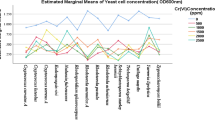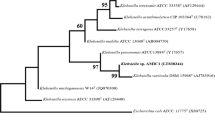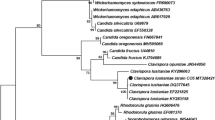Abstract
The present study is aimed at isolating a heavy metal and non-metallic pollutants tolerant microorganism from wastewater samples which has the highest capability to remove toxicants from contaminated water bodies. From the wastewater samples of Tolly Canal, 35 bacterial, 10 yeast and 5 filamentous fungal strains were isolated and tested for their toxicant tolerance capacities. The obtained isolates were subjected to gradually increasing concentration of toxic metal salts Pb(CH3COO)2.3H2O, NiSO4.6H2O, CuSO4.5H2O, CdCl2.H2O, NaF, NaAsO2. All the isolated strains reached the minimal inhibitory concentration much earlier than a yeast strain named as JIC. The strain was proved to be the most toxicant tolerant and also showed efficient toxicant removal capacity by employing 10 ppm of each of the pollutants. It showed removal capacities of Cd (II) (43.60%), Pb (II) (38.20%), Cu (II) (22.60%), As (III) (31.20%), F−(27.60%) and Ni (II) (24.80%). The isolated strain has been undergone some biochemical and phylogenetic analyses for identification and subsequently found to be a strain of Candida tropicalis. The Internal Transcribed Spacer (ITS) 1–4 RNA gene sequence obtained was deposited to National Center for Biotechnology Information (NCBI) and finally the accession number has been obtained as Candida tropicalis isolate JIC MZ798901.



Similar content being viewed by others
Abbreviations
- EDAX:
-
Energy-dispersive X-ray
- ITS:
-
Internal Transcribed Spacer
- FT-IR:
-
Fourier Transform Infrared
- SEM:
-
Scanning Electron Microscope
References
Acosta-Rodriguez I, Cardenas-Gonzalez FC, Martinez Juarez VM, Perez AR, Moctezuma Zarate MG, Pacheco Castillo NC (2018) Biosorption of heavy metals by Candida albicans. In Advances in Bioremediation and Phytoremediation, 1st ed., ed. Shiomi N, Intechopen, Croatia
Ahalya N, Ramachandra T, Kanamadi R (2003) Biosorption of heavy metals. Res J Chem Environ 7:71–79
Ali H, Khan E, Ilahi I (2019a) Environmental chemistry and ecotoxicology of hazardous heavy metals: environmental persistence, toxicity, and bioaccumulation. J Chem 2019:6730305. https://doi.org/10.1155/2019/6730305
Ali S, Fakhri Y, Golbini M, Thakur SK, Alinejad A, Parseh I, Shekhar S, Bhattacharya P (2019b) Concentration of fluoride in groundwater of India: A systematic review, meta-analysis and risk assessment. Groundw Sustain Dev 9:100224. https://doi.org/10.1016/j.gsd.2019.100224
Annadurai ST, Arivalagan P, Sundaram R, Mariappan R, Munusamy AP (2019) Batch and column approach on biosorption of fluoride from aqueous medium using live, dead and various pretreated Aspergillus niger (FS18) biomass. Surf Interfaces 15:60–69. https://doi.org/10.1016/j.surfin.2019.01.013
Arabi M, Golshani N (2016) Removal of copper ions Cu(II) from industrial wastewater: a review of removal methods. Int J Epidemiol Res 3:283–293
Barakat MA (2011) New trends in removing heavy metals from industrial wastewater. Arab J Chem 4:361–377. https://doi.org/10.1016/j.arabjc.2010.07.019
Benson HJ (1994) Microbiological applications. Laboratory Manual in General Microbiology. Wan C. Brown Publishers, Dubuque, pp 120–139
Bhattacharyya K, Sen D, Laskar P, Saha T, Kundu G, Chaudhuri AG, Ganguly S (2021) Pathophysiological effects of cadmium(II) on human health-a critical review. J Basic Clin Physiol Pharmacol. https://doi.org/10.1515/jbcpp-2021-0173
Bienert GP, Tamás MJ (2018) Editorial: Molecular mechanisms of metalloid transport, toxicity and tolerance. Front Cell Dev Biol 6:99. https://doi.org/10.3389/fcell.2018.00099
Bilal M, Rasheed T, Sosa-Hernández JE, Raza A, Nabeel F, Iqbal HMN (2018) Biosorption: An interplay between marine algae and potentially toxic elements—A review. Mar Drugs 16:1–16. https://doi.org/10.3390/md16020065
Bind A, Goswami L, Prakash V (2018) Comparative analysis of floating and submerged macrophytes for heavy metal (copper, chromium, arsenic and lead) removal: sorbent preparation, characterization, regeneration and cost estimation. Geol Ecol Land 2:61–72. https://doi.org/10.1080/24749508.2018.1452460
Buzan B, Lawson G (2015) The gobal transformation: history modernity and the making of international relations. Cambridge University Press, Cambridge
Cefali E, Patane S, Arena A, Saitta G, Guglielmino S, Cappello S, Nicolo M, Allegrini M (2002) Morphologic variations in bacteria under stress conditions: near-field optical studies. Scanning 24:274–283. https://doi.org/10.1002/sca.4950240601
Chatterjee A, Abraham J (2019) Desorption of heavy metals from metal loaded sorbents and e-wastes: a review. Biotechnol Lett 41:319–333. https://doi.org/10.1007/s10529-019-02650-0
Chojnacka K (2010) Biosorption and bioaccumulation-the prospects for practical applications. Environ Int 36:299–307. https://doi.org/10.1016/j.envint.2009.12.001
Collins JF (2021) Copper nutrition and biochemistry and human (patho)physiology. Adv Food Nutr Res 96:311–364. https://doi.org/10.1016/bs.afnr.2021.01.005h
deVega C, Herrera CM, Johnson SD (2009) Yeasts in floral nectar of some South African plants: Quantification and associations with pollinator type and sugar concentration. S Afr J Bot 75:798–806. https://doi.org/10.1016/j.sajb.2009.07.016
Dhankhar R, Hooda A (2011) Fungal biosorption-an alternative to meet the challenges of heavy metal pollution in aqueous solutions. Environ Technol 32:467–491. https://doi.org/10.1080/09593330.2011.572922
do Nascimento JM, de Oliveira JD, Rizzo ACL, Leite SGF (2019) Biosorption of Cu(II) by the yeast Saccharomyces cerevisiae. Biotechnol Rep 21:e00315. https://doi.org/10.1016/j.btre.2019.e00315
Dusengemungu L, Kasali G, Gwanama C, Ouma KO (2020) Recent advances in biosorption of copper and cobalt by filamentous fungi. Front Microbiol 11:1–16. https://doi.org/10.3389/fmicb.2020.582016
Edelstein M, Ben-Hur M (2017) Heavy metals and metalloids: Sources, risks and strategies to reduce their accumulation in horticultural crops. Sci Hortic 234:431–444. https://doi.org/10.1016/j.scienta.2017.12.039
El-Naggar NEA, Rabei NH (2020) Bioprocessing optimization for efficient simultaneous removal of methylene blue and nickel by Gracilaria seaweed biomass. Sci Rep 10:17439. https://doi.org/10.1038/s41598-020-74389-y
El-Sheekh M, Sabagh S, El-Souod GA, Elbeltagy A (2019) Biosorption of cadmium from aqueous solution by free and immobilized dry biomass of Chlorella vulgaris. Int J Environ Res 13:511–521. https://doi.org/10.1007/s41742-019-00190-z
Ezaka E, Anyanwa CU (2011) Chromium(VI) tolerance of bacterial strains isolated from sewage oxidation ditch. Int J Environ Sci 1:1725–1734 (ISSN 0976-4402)
Farhan AM, Al-Dujaili AH, Awwad AM (2013) Equilibrium and kinetic studies of cadmium(II) and lead(II) ions biosorption onto Ficus carcia leaves. Int J Ind Chem 4:24. https://doi.org/10.1186/2228-5547-4-24
Fathollahi A, Khasteganan N, Coupe SJ, Newman AP (2021) A meta-analysis of metal biosorption by suspended bacteria from three phyla. Chemosphere 268:129290. https://doi.org/10.1016/j.chemosphere.2020.129290
Felsenstein J (1985) Confidence limits on phylogenies: An approach using the bootstrap. Evolution 39:783–791. https://doi.org/10.1111/j.1558-5646.1985.tb00420.x
Gadd GM (2009) Biosorption: a critical review of scientific rationale, environmental importance and significance for pollution treatment. J Chem Tecnol Biotechnol 84:13–28. https://doi.org/10.1002/jctb.1999
García-Béjar B, Arévalo-Villena M, Guisantes-Batan E, Rodríguez-Flores J, Briones A (2020) Study of the bioremediatory capacity of wild yeasts. Sci Rep 10:11265. https://doi.org/10.1038/s41598-020-68154-4
Genchi G, Sinicropi MS, Lauria G, Carocci A, Catalano A (2020a) The effects of cadmium toxicity. Int J Environ Res Public Health 17:3782. https://doi.org/10.3390/ijerph17113782
Genchi G, Carocci A, Lauria G, Sinicropi MS (2020b) Nickel: Human Health and Environmental Toxicology. Int J Environ Res Public Health 17:679. https://doi.org/10.3390/ijerph17030679
George B, Kumar JIN, Kumar RN, Sajish PR (2012) Biosorption potentiality of living Aspergillus niger Teigh in removing heavy metal from aqueous solution. Bioremediat J 16:195–203. https://doi.org/10.1080/10889868.2012.731442
Glasser NR, Oyala PH, Osborne TH, Santini JM, Newman DK (2018) Structural and mechanistic analysis of the arsenate respiratory reductase provides insight into environmental arsenic transformations. Proc Natl Acad Sci U S A 115:E8614–E8623. https://doi.org/10.1073/pnas.1807984115
Gunjal A, Waghmode M, Patil N, Kapadnis B (2019) Biosorption of cadmium and nickel by pretreated Aspergillus spp. biomass. Indian J Exp Biol 57:460–464
Guth S, Hüser S, Roth A, Degen G, Diel P, Edlund K, Eisenbrand G, Engel KH, Epe B, Grune T, Heinz V, Henle T, Humpf HU, Jäger H, Joost HG, Kulling SE, Lampen A, Mally A, Marchan R, Marko D, Mühle E, Nitsche MA, Röhrdanz E, Stadler R, van Thriel C, Vieths S, Vogel RF, Wascher E, Watzl C, Nöthlings U, Hengstler JG (2020) Toxicity of fluoride: critical evaluation of evidence for human developmental neurotoxicity in epidemiological studies, animal experiments and in vitro analyses. Arch Toxicol 94:1375–1415. https://doi.org/10.1007/s00204-020-02725-2
Hawkes JS (1997) Heavy metals. J Chem Educ 74:1374. https://doi.org/10.1021/ed074p1374
Hiremath PG, Theodore T (2017) Modelling of fluoride sorption from aqueous solution using green algae impregnated with zirconium by response surface methodology. Adsorp Sci Technol 35:194–217. https://doi.org/10.1177/0263617416674014
Hunter BB, Hoyes JV, Barnett HL (1974) The additions of aureomycin and chloramphenicol to various fungal agar media to prevent bacterial contamination. Proc Pennsylvania Acad Sci 48:88–92. https://www.jstor.org/stable/44112504
Izquierdo M, Gabaldon C, Mazal P, Alvarez-Hornos FJ (2010) Modeling of copper fixed-bed biosorption from wastewater by Posidonia oceanica. Bioresour Technol 101:510–517. https://doi.org/10.1016/j.biortech.2009.08.018
Kanamarlapudi SLRK, Chintalpudi VK, Muddada S (2018) Application of biosorption for removal of heavy metals from wastewater. In Biosorption. In Tech. https://doi.org/10.5772/intechopen.77315
Kelepertzis E (2014) Accumulation of heavy metals in agriculture soils of Mediterranean : insights from Argolida basin, Peloponnese, Greece. Geoderma 221–222:82–90. https://doi.org/10.1016/j.geoderma.2014.01.007
Khan Z, Rehman A, Nisar MA, Zafar S, Hussain SZ, Zerr I, Hussain I, Waseem M, Arif M (2017) Molecular basis of Cd2+ stress response in Candida tropicalis. Appl Microbiol Biotechnol 101:7715–7728. https://doi.org/10.1007/s00253-017-8503-2
Kunova Z, Pieckova E (2002) Isolation of fluconazole-tolerant micromycetes onto different cultivation media. Folia Microbiol (Praha) 47:113–117. https://doi.org/10.1007/BF02817667
Larkin MA, Blackshields G, Brown NP, Chenna R, McGettigan PA, McWilliam H, Valentin F, Wallace IM, Wilm A, Lopez R, Thompson JD (2007) Clustal W and Clustal X version 2.0. Bioinformatics 23:2947–2948
Leck A (1999) Preparation of lactophenol cotton blue slide mounts. Commun Eye Health 12:24
Li H, Dong W, Liu Y, Zhang H, Wang G (2019) Enhanced biosorption of nickel ions on immobilized surface-engineered yeast using nickel-binding peptides. Front Microbiol 10:1254. https://doi.org/10.3389/fmicb.2019.01254
Madala S, Nadavala SK, Vudagandla S, Boddu VM, Abburi K (2017) Equilibrium, kinetics and thermodynamics of Cadmium (II) biosorption on to composite chitosan biosorbent. Arab J Chem 10:S1883–S1893. https://doi.org/10.1016/j.arabjc.2013.07.017
Mahmoud ME, Yakout AA, Abed El Aziz MT, Osman M, Abdel-Fattah TM (2015) A novel cellulose-dioctyl pthaate-baker’s yeast biosorbent for removal of Co(II), Cu(II), Cd (II), Hg(II), and Pb(II). J Environ Sci Health A 50:1072–1081. https://doi.org/10.1080/10934529.2015.1038184
Marzan LW, Hossain M, Mina SA, Akter Y, Chowdhury AMMA (2017) Isolation and biochemical characterization of heavy-metal resistant bacteria from tannery effluent in Chittagong city, Bangladesh: Bioremediation viewpoint. Egypt J Aquat Res 43:65–74. https://doi.org/10.1016/j.ejar.2016.11.002
Massoud R, Hadiani MR, Hamzehlou P, Khosravi-Darani K (2019) Bioremediation of heavy metals in food industry: application of Saccharomyces cerevisiae. Electron J Biotechnol 37:56–60. https://doi.org/10.1016/j.ejbt.2018.11.003
Michalak I, Mironiuk M, Marycz K (2018) A comprehensive analysis of biosorption of metal ions by macroalgae using ICP-OES, SEM-EDX and FTIR techniques. PLoS One. https://doi.org/10.1371/journal.pone.0205590
Mishra J, Singh R, Arora NK (2017) Alleviation of heavy metal stress in plants and remediation of soil by rhizosphere microorganisms. Front Microbiol 8:1706. https://doi.org/10.3389/fmicb.2017.01706
Mitic-Stojanovic DL, Zarubica A, Purenovic M, Bojic D, Andjelkovic T, Bojic AL (2011) Biosorptive removal of Pb2+, Cd2+ and Zn2+ ions from water by Lagenaria vulgaris shell. Water SA 37:303–312. https://doi.org/10.4314/wsa.v37i3.68481
Mohan D, Pittman CU (2007) Arsenic removal from water/wastewater using adsorbents-A critical review. J Hazard Mater 142:1–53. https://doi.org/10.1016/j.jhazmat.2007.01.006
Mohebbrad B, Bonyadi Z, Dehghan AA, Rahmat MH (2018) Arsenic removal from aqueous solutions using Saccharomyces cerevisiae: kinetic and equilibrium study. Environ Prog Sustain Energy 38. https://doi.org/10.1002/ep.13074
Muhammad S, Shah MT, Khan S (2011) Health risk assessment of heavy metals and their source apportionment in drinking water of Kohistan region, northern Pakistan. Microchem J 98:334–343. https://doi.org/10.1016/j.microc.2011.03.003
Mukhopadhyay R, Rosen BP (2002) Arsenate reductases in prokaryotes and eukaryotes. Environ Health Perspect 110:745–748. https://doi.org/10.1289/ehp.02110s5745
Murinda SE, Nguyen LT, Headrick SJ, Meleo P, Oliver S (2006) Potential of antimicrobial agents to inhibit fungi to aid isolation of Camplylobacter. Foodborne Pathog Dis 3:309–314. https://doi.org/10.1089/fpd.2006.3.309
Musa OK, Shaibu MM, Kudamnya EA (2013) Heavy metal concentration in groundwater around Obajana and its environs, Kogi State, North Central Nigeria. Am Int J Contemp Res 3:170–177
Mwandira W, Nakashima K, Kawasaki S, Arabelo A, Banda K, Nyambe I, Chirwa M, Ito M, Sato T, Igarashi T, Nakata H, Nakayama S, Ishizuka M (2020) Biosorption of Pb(II) and Zn(II) from aqueous solution by Oceanobacillus profundus isolated from an abandoned mine. Sci Rep 10:21189. https://doi.org/10.1038/s41598-020-78187-4
Nagano Y, Millar CB, Goldsmith CE, Walker JM, Elborn JS, Rendall J, Moore JE (2008) Development of selective media for the isolation of yeasts and filamentous fungi from the sputum of adult patients with cystic fibrosis (CF). J Cyst Fibros 7:566–572. https://doi.org/10.1016/j.jcf.2008.06.007
Ojima Y, Kosako S, Kihara M, Miyoshi N, Igarashi K, Azuma M (2019) Recovering metals from aqueous solutions by biosorption onto phosphorylated dry baker’s yeast. Sci Rep 9:225. https://doi.org/10.1038/s41598-018-36306-2
Padua JCD, dela Cruz TEE (2021) Isolation and characterization of nickel-tolerant Trichoderma strains from marine and terrestrial environments. J Fungi 7:591. https://doi.org/10.3390/jof7080591
Rahman MS, Ahmed ASS, Rahman MM, Babu SMOF, Sultana S, Sarker SI, Awual R, Rahman MM, Rahman M (2021) Temporal assessment of heavy metal concentration and surface water quality representing the public health evaluation from the Meghna River estuary, Bangladesh. Appl Water Sci 11:121. https://doi.org/10.1007/s13201-021-01455-9
Rehman A, Anjum MS, Hasnain S (2010) Cadmium biosorption by yeast, Candida tropicalis CBL-1 isolated from industrial wastewater. J Gen Appl Microbiol 56:359–368. https://doi.org/10.2323/jgam.56.359
Satya A, Harimawan A, Haryani GS, Johir MAH, Vigneswaran S, Ngo HH, Setiadi T (2020) Batch study of cadmium biosorption by carbon dioxide enriched Aphanothece sp. dried biomass. Water (Switzerland) 12:264. https://doi.org/10.3390/w12010264
Shankar S, Shanker U, Shikha (2014) Arsenic contamination of groundwater: a review of sources, prevalence, health risks, and strategies for mitigation. Sci World J 2014:304524. https://doi.org/10.1155/2014/304524
Shanker AS, Srinivasulu D, Pindi PK (2020) A study on bioremediation of fluoride-contaminated water via a novel bacterium Acinetobacter sp. (GU566361) isolated from potable water. Results Chem 2:100070. https://doi.org/10.1016/j.rechem.2020.100070
Sultana N, Hossain SMZ, Mohammed ME, Irfan MF, Haq B, Faruque MO, Razzak SA, Hossain MM (2020) Experiment study and parameters optimization of microalgae based heavy metals removal process using a hybrid response surface methodology-crow search algorithm. Sci Rep 10:15068. https://doi.org/10.1038/s41598-020-72236-8
Tabassum N, Das S, Ghosh M (2020) Scientific study of dying rivers for societal benefits: a comparative analysis of two rivers in two south asian countries. Int J Sci Technol Res 9: ISSN 2277–8616
Tamura K, Nei M (1993) Estimation of the number of nucleotide substitutions in the control region of mitochondrial DNA in humans and chimpanzees. Mol Biol Evol 10:512–526. https://doi.org/10.1093/oxfordjournals.molbev.a040023
Tamura K, Stecher G, Kumar S (2021) MEGA 11: molecular evolutionary genetics analysis version 11. Mol Biol Evol 38:3022–3027. https://doi.org/10.1093/molbev/msab120
Tanvi DA, Pratam KM, Lohit RT, Vijayalakshmi BK, Devaraja TN, Vasudha M, Ramesh A, Chakra PS, Gayathri D (2020) Biosorption of heavy metal arsenic from industrial sewage of Davangere District, Karnataka, India, using indigenous fungal isolates. SN Appl Sci 2:1860. https://doi.org/10.1007/s42452-020-03622-0
Tariq A, Ullah U, Asif M, Sadiq I (2019) Biosorption of arsenic through bacteria isolated from Pakistan. Int Microbiol 22:59–68. https://doi.org/10.1007/s10123-018-0028-8
Taylor AA, Tsuji JS, Garry MR, McArdle ME, Goodfellow WL Jr, Adams WJ, Menzie CA (2020) Critical review of exposure and effects: implications for setting regulatory health criteria for ingested copper. Environ Manage 65:131–159. https://doi.org/10.1007/s00267-019-01234-y
Tchounwou PB, Yedjou CG, Patlolla AK, Sutton DJ (2012) Heavy metals toxicity and the environment. In: Luch A (ed) Molecular, Clinical and Environmental Toxicology. Experimentia Supplementum, vol 101. Springer, Basel
Tripathi AK, Kohli S (2013) Anti-diabetic activity and phytochemical screening of crude extracts of Pueraria tuberosa DC. (FABACEAE) grown in India on STZ-induced diabetic rats. Asian J Med Pharm Re 3:66–73 (ISSN 2322-4789)
Wani AL, Ara A, Usmani JA (2015) Lead toxicity: a review. Interdiscip Toxicol 8:55–64. https://doi.org/10.1515/intox-2015-0009
WHO (2017) Guidelines for drinking water quality: fourth edition incorporating the first addendum. World Health Organization, Geneva (License: CC BY-NC-SA 3.0 IGO)
Yadav KK, Kumar S, Pham QB, Gupta N, Rezania S, Kamyab H, Yadav S, Vymazal J, Kumar V, Tri DQ, Talaiekhozani A, Prasad S, Reece LM, Singh N, Maurya PK, Cho J (2019) Fluoride contamination, health problems and remediation methods in Asian groundwater: a comprehensive review. Ecotoxicol Environ Saf 182:109362. https://doi.org/10.1016/j.ecoenv.2019.06.045
Acknowledgements
The authors would like to thank CRNN, University of Calcutta, Bose Institute, Indian Association for the Cultivation Of Science, Jadavpur, Kolkata, S.N. Bose National Centre for Basic Sciences and CSIR-Indian Institute Of Chemical Biology (IICB) for providing necessary technical supports for analysis of samples and to Dr. Smaranika Pattanaik (DSc.), Assistant Professor, Department of Biotechnology and Bioinformatics, Medical Microbiotechnology Laboratory, Sambalpur University, Odisha, India, our research collaborator for her kind assistance in testing the virulence of the isolated Candida tropicalis isolate JIC MZ798901.
Funding
The work was financially supported by the Council of Scientific & Industrial Research, Human Resource Development Group (Extra Mural Research Division), CSIR Complex, Library Avenue, Pusa, New Delhi 110012, India, Award Letter Number:08/463(0001)/2019-EMR-1.
Author information
Authors and Affiliations
Contributions
The experiment was conceptualized and designed by Dr. Subhadeep Ganguly. The experiment was conducted by Kaustav Bhattacharyya, Debrup Sen and Basab B. Dey. The molecular phylogenetic analysis and tree construction were done by Dr. Arijit De. FTIR-ATR data have been explained by Dr. Neelanjan Bhattacharjee. The concept was theoretically enriched by Dr. Asit Baran Biswas.
Corresponding author
Ethics declarations
Competing interest
The authors declare that there is no conflict of interest.
Additional information
Publisher's note
Springer Nature remains neutral with regard to jurisdictional claims in published maps and institutional affiliations.
Rights and permissions
About this article
Cite this article
Bhattacharyya, K., Sen, D., Dey, B.B. et al. Isolation and characterization of heavy metals and non-metallic pollutant-tolerant microorganism from wastewater of Tollygunge Canal (Kolkata) West Bengal, India. Biologia 77, 2359–2369 (2022). https://doi.org/10.1007/s11756-022-01086-8
Received:
Accepted:
Published:
Issue Date:
DOI: https://doi.org/10.1007/s11756-022-01086-8




